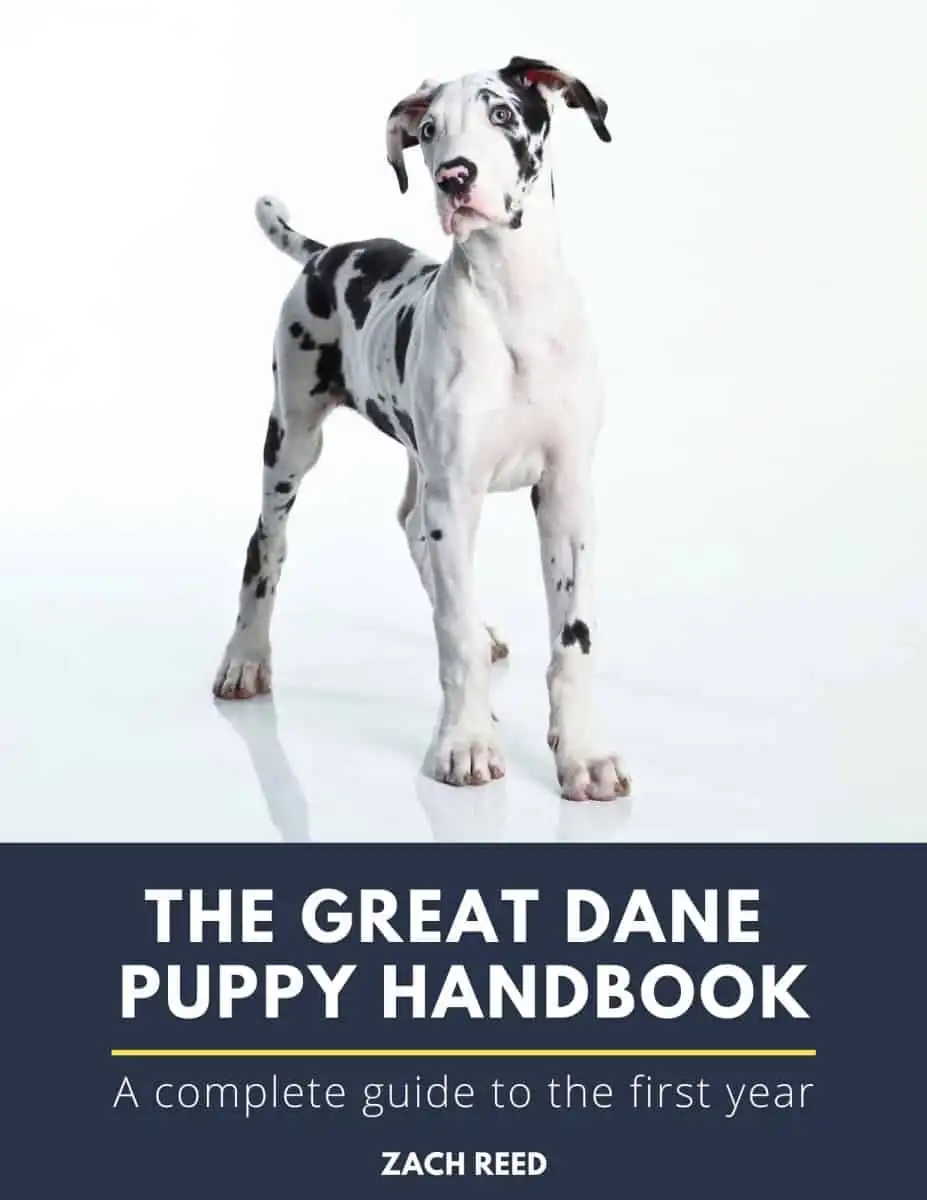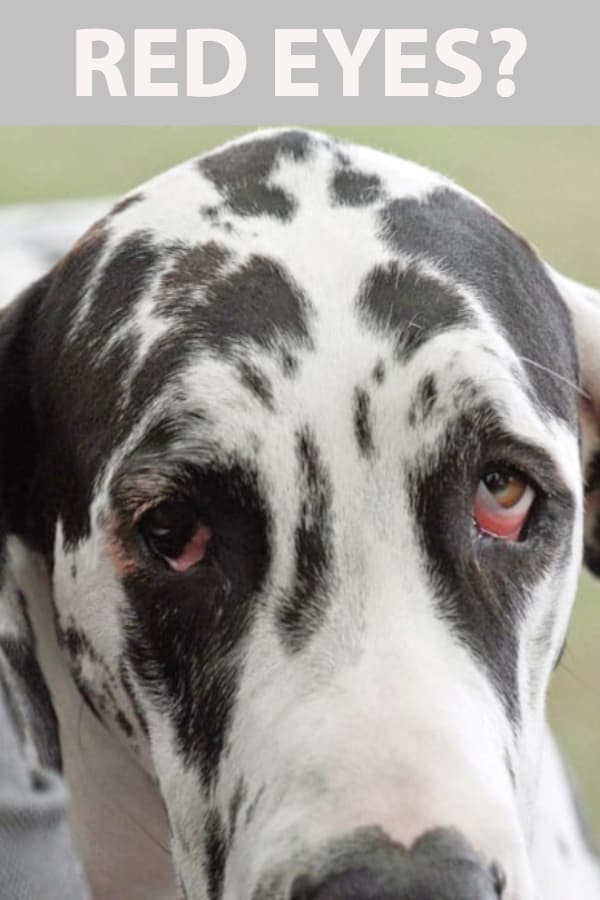
When you think of dogs with droopy red eyes, you probably automatically picture a cute little bloodhound with floppy ears and a long face. But these saggy, droopy faces aren’t just reserved to one breed—many can be affected, including Great Danes.
Let’s face it, people are suckers for puppies with droopy eyes. Who could resist?! Although they may be cute, sagging eyes can be more harmful than adorable.
Tight eyelids that fit snug across a dog’s face are important for maintaining eye health. The skin around the eyes helps keep out debris and dirt so your pup can make use of their full vision. It also protects against developing other infections.
Some breeds, like Great Danes, are more likely to develop red, sagging eyes. Although they may not require frequent bathing like most dogs do, keeping up with facial hygiene can really pay off in the long run.
After long days of play or between baths, mucus can start to build up around your Dane’s eyes. Simply wipe down with a warm, wet towel so nothing obstructs their view and to keep their eyelids healthy and clean.
If you notice that your Dane’s eyes are starting to droop or turn red, it could be a normal effect of aging. However, red eyes can also signal that your dog is experiencing irritation, developing an infection, or is suffering from a condition like entropion, ectropion, glaucoma, or cataracts.
For more information about caring for a Great Dane, please make sure to consider my book “The Great Dane Puppy Handbook“.
The Great Dane Puppy Handbook takes all of the need-to-know Great Dane info and packages it together into a single, concise resource. Save yourself time, money, and frustration by avoiding the most common mistakes made by Great Dane owners!
Read more about each of these ailments below and find out how to identify them.
Ectropion
What is it and how does it occur?
Ectropion is the medical term for when a dog’s lower eyelid starts to droop and roll outward from the eyeball.
This exposes their mucus membrane to dirt and bacteria from the environment and puts them at risk for infections. It can start out in one eye, but it is likely to spread to both eventually.
This is the most recognizable form of red drooping eyes and is primarily caused through selective breeding. Since it is an inherited trait, it is relatively easy to stop the spread to other dogs.
Breeders need to stop choosing to breed from dogs who display ectropion and the condition will eventually be largely eliminated.
Dog breeds that have loose skin around their faces have a higher probability of having ectropion. If you are aware that your puppy’s parents had drooping eyes, it will most likely show up in your dog as well.
Signs of Ectropion
A tell-tale sign of ectropion are sore, inflamed eyes with protruding lower eyelids. When the lower eyelid doesn’t make contact with the eyeball, it gives the appearance of red, sagging eyes.
Other signs include tear stains and discharge coming from the eye. This can start to make the eyelid heavy and begin to droop down. Once the eyelid sinks too far from the eye, it can start to cause issues.
Puppies can start showing symptoms of ectropion as early as a few months old. But sometimes symptoms aren’t always immediately obvious—it can also develop in older dogs as a sign of losing tension in the skin or show up temporarily after exercise or long naps on the hardwood.
It is important to keep an eye (no pun intended ;)) on your dog’s eyes and make note of any changes.
Treatment Options
As of today, there is not a permanent correction for ectropion. If your dog has been diagnosed with this condition, there are a few ways to manage it.
Typically after a visit to the vet, you will get a prescription lubricant to help aid in pain and to prevent the eye from drying out.
Surgery can also help and might be a good option if your Dane experiences multiple and frequent eye infections. It’s basically a doggy face lift!
If you think your dog may be displaying signs of ectropion, you may want to make an appointment with your vet. It is important to tackle these issues as soon as they arise in order to prevent the problem from worsening.
Entropion
What is it and how does it occur?
Entropion is the medical term for when a dog’s eyelids roll inward. This can occur either on the bottom or top eyelid and even on the sides of the eyes.
This condition causes the dog’s eyelids to touch and the eyelashes to rub against the eye itself, causing irritation to the cornea. This bothersome situation can lead to chronic ulcers and painful, squinty eyes.
You might know the pain of having one eyelash poke you in your eye, can you imagine an eyelid full rubbing against your eyeball?
Ouch!
This condition can be commonly found across young rapidly growing pure-bred dogs. There are three types of entropion:
Inherited Entropion
Inherited is the most common form and is seen in breeds with loose skin around the eyes. Think Shar-peis, Chows, and even Great Danes!
Spastic Entropion
This type of entropion is triggered by muscle spasms that cause the eyelids to rub against the eye. This can be an effect of other eye health issues, such as a corneal ulcer, the dog is experiencing.
This can happen to any breed at any age.
Acquired Entropion
With this type of entropion, a dog’s eyelids roll inward as a result of changes to the eye or the muscles surrounding it. This causes the eyeball to shrink and start to roll in towards the nose.
This is usually typical in older dogs or dogs with established eye problems.
Signs of Entropion
Typical indicators of entropion are:
- tears or mucus discharge from the eyes
- excessive squinting
- pawing or rubbing at the eyes
- scratches or cuts on the cornea
- redness
- eye tics
As it progresses, it is possible for the cornea to develop brown pigment.
If your dog looks uncomfortable or starts to fiddle with their eyes, it may be a sign that they are developing entropion. Be sure to call your vet if the problems persist so your pup can get immediate care!
Treatment Options
Fortunately, entropion in dogs can be treated. Vets typically have options for eye drops or ointments that relieve pain and discomfort while also protecting the eye from being rubbed too much.
In puppies, temporary tacking of the eyelids can allow the dog to outgrow the entropion as its skull features mature. The procedure may have to be done a few times, but once the dog ages a few months and their eyelids adjust, they are able to remove the stitches.
However, sometimes puppies never outgrow their entropion and surgery is required to correct the position of eyelids and maintain eye health.
If left untreated, entropion can lead to vision defects caused by the tearing and scarring of the cornea. With proper care and precautions, you can ensure your Dane has healthy, comfortable, and visual eyes.
Glaucoma
What is it and how does it occur?
Glaucoma is one of the most distinguishable red eye problems in dogs and unfortunately, Great Danes are especially inclined to develop this genetic and painful condition.
Glaucoma occurs when fluids in the eye can’t move or drain properly and causes an increase in internal pressure. This can lead to a change in structure and function of the eye.
There are two types of glaucoma— primary and secondary.
Primary glaucoma is easier to predict and anticipate since it is a hereditary condition that takes over a healthy eye. It is essential to stay on top of eye exams in order to spot the signs and begin treatment right away.
Secondary glaucoma is caused by another disease or injury to the eye. This can be instigated by infections, tumors, inflammation of the eye, blood clots, or damages to the lens.
Signs of Glaucoma
If your Dane starts displaying odd behavior towards their eyes, such as pawing or endless scratching, some closer inspection may be needed.
Some common indicators for glaucoma are:
- Excessive tear production
- Constant blinking
- Blurry vision (or running into things)
- Squinting
- Eye bulging
- Closed or swollen eye
- Redness of the sclera (the white part of the eye)
- Cloudy or blue cornea
Treatment Options
If you catch the signs for glaucoma early enough for your Great Dane to be treated, vets will usually prescribe medications to lower the fluid pressure in the affected eyes and help out with pain and discomfort.
Managing glaucoma involves periodic visits to the vet to monitor eye pressure and ensure healthy vision. In severe or advanced cases, surgery must be combined with medical treatment in order to relieve the pressure.
In cases where surgery or medicine doesn’t help the affected eye, or if blindness has developed, removal of the eye may be recommended to relieve the distress.
Cataracts
What is it and how does it occur?
When someone says that a dog has cataracts, they are usually referring to the opaque layer that develops on their lens, or “cloudiness” of the lens, which can range from partial to total opacity.
When an eye lens gets cloudy, it prevents light from entering the retina, initiating vision loss.
A dog can either have juvenile or bilateral cataracts. As you might have guessed, juvenile cataracts are inherited and have been even known to occur as early as the age of 6 months.
Bilateral cataracts can develop as your Dane ages, or alongside other common ailments like glaucoma, diabetes, inflammation of the eye, nutritional disorders, or eye injuries.
Signs of Cataracts
Cataracts is a progressive disorder, so it can worsen by the day—the earlier you catch it, the better.
Be sure to consult your vet if your dog’s eyes start to appear red or bloodshot or if they start squinting.
Other signs are cloudiness of the eye, vision loss, bumping into walls or furniture in the living rooms, or not recognizing familiar faces.
Treatment Options
Surgery is the most common form of treatment for doggy cataracts. The procedure entails the removal of the lens and replaces it with an artificial one.
However, the surgery poses a series of risks and is also quite expensive since it requires a veterinary ophthalmologist, or a specialized eye doctor for dogs.
When surgery isn’t an option, dog owners typically try to accommodate for their pets’ deteriorating eye sight by keeping a familiar set up throughout their home and relying primarily on noises and touch to communicate with their dog.
Red eye wrap-up
Although dogs with red, droopy eyes may seem delightful and lovable, they come with a list of health risks that you need to be aware of.
This means taking extra care of your droopy eyed Dane when outside playing to make sure they keep away from dust and dirt when possible!
You will also need to act promptly when infections set in so they don’t progress into worse conditions.
Keep in mind that these are just a few of the conditions that could lead to Great Dane red eyes. Just because the signs seen in your dog don’t match those listed above doesn’t mean that there isn’t something wrong.
Cherry eye and eye infections are other potential causes that will be covered in separate articles. Make sure to always consult with your veterinarian if you’re unsure.
If you are looking to buy a new puppy, it is important to consider the predispositions of Great Danes. Be aware of the breeder and whether the puppy’s parents have a history of eye problems.
Take the time to research these issues and learn the signs of them so you can love your healthy and happy Great Dane!


